Higher levels of myelin phospholipids in brains of neuronal α-Synuclein transgenic mice precede myelin loss
- PMID: 28482862
- PMCID: PMC5421332
- DOI: 10.1186/s40478-017-0439-3
Higher levels of myelin phospholipids in brains of neuronal α-Synuclein transgenic mice precede myelin loss
Abstract
α-Synuclein is a protein involved in the pathogenesis of synucleinopathies, including Parkinson's disease (PD), dementia with Lewy bodies (DLB) and multiple system atrophy (MSA). We investigated the role of neuronal α-Syn in myelin composition and abnormalities. The phospholipid content of purified myelin was determined by 31P NMR in two mouse lines modeling PD, PrP-A53T α-Syn and Thy-1 wt-α-Syn. Significantly higher levels of phospholipids were detected in myelin purified from brains of these α-Syn transgenic mouse models than in control mice. Nevertheless, myelin ultrastructure appeared intact. To further investigate the effect of α-Syn on myelin abnormalities, we systematically analyzed the striatum, a brain region associated with neurodegeneration in PD. An age and disease-dependent loss of myelin basic protein (MBP) signal was detected by immunohistochemistry in striatal striosomes (patches). The age-dependent loss of MBP signal was associated with lower P25α levels in oligodendrocytes. In addition, we found that α-Syn inhibited oligodendrocyte maturation and the formation of membranous sheets in vitro. Based on these results we concluded that neuronal α-Syn is involved in the regulation and/or maintenance of myelin phospholipid. However, axonal hypomyelination in the PD models is evident only in progressive stages of the disease and associated with α-Syn toxicity.
Keywords: Myelin; Parkinson’s disease; Phospholipids; α-Synuclein.
Figures
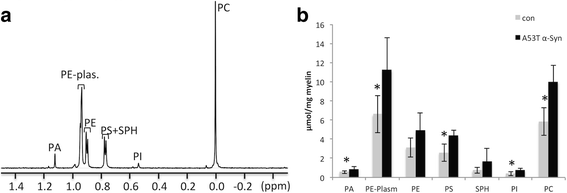
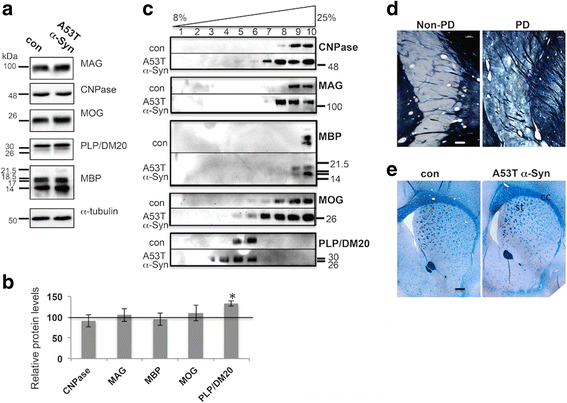
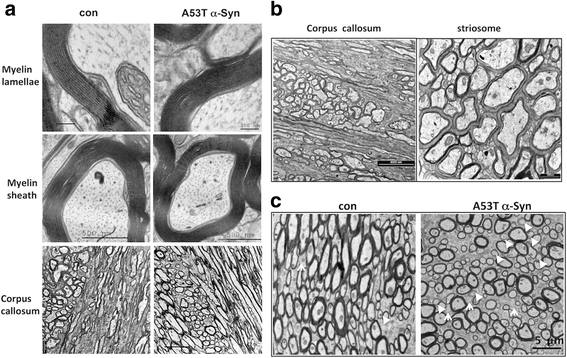
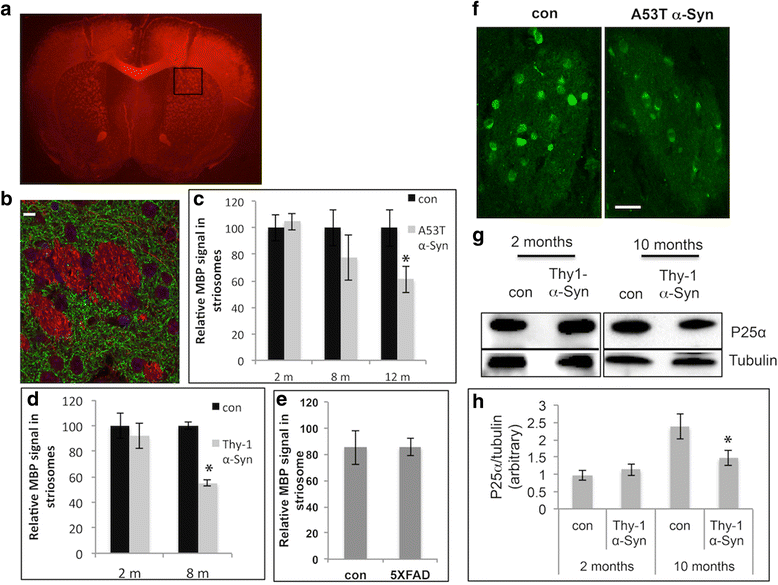
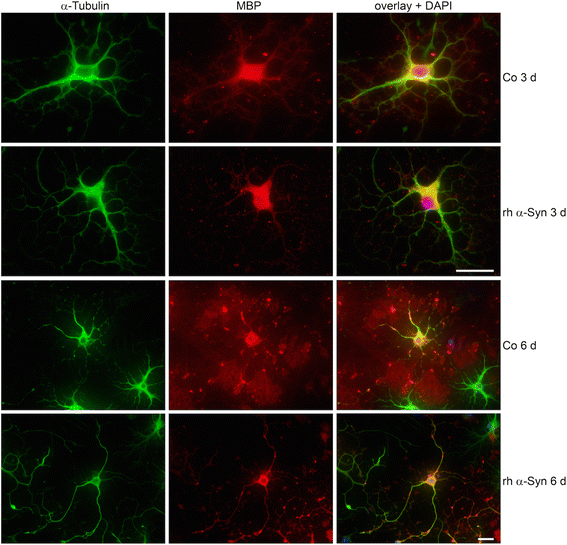
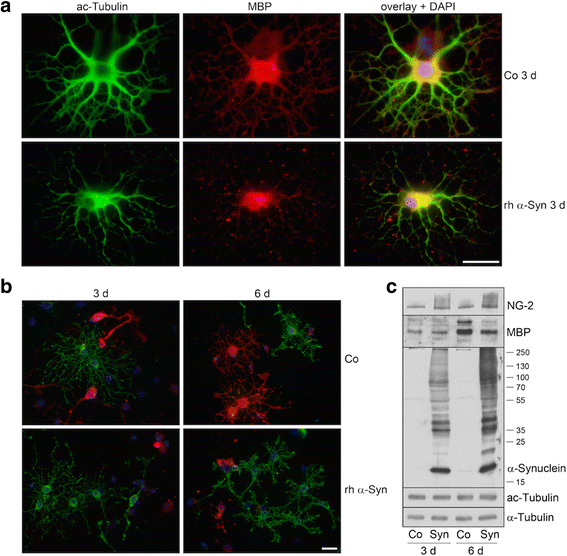
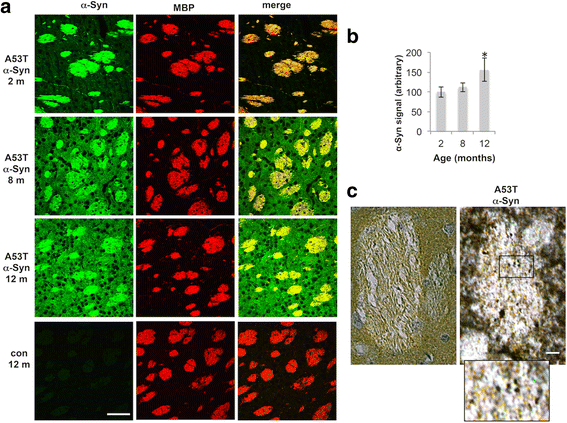
Similar articles
-
Overexpression of α-Synuclein by Oligodendrocytes in Transgenic Mice Does Not Recapitulate the Fibrillar Aggregation Seen in Multiple System Atrophy.Cells. 2020 Oct 29;9(11):2371. doi: 10.3390/cells9112371. Cells. 2020. PMID: 33138150 Free PMC article.
-
Calpain-cleavage of alpha-synuclein: connecting proteolytic processing to disease-linked aggregation.Am J Pathol. 2007 May;170(5):1725-38. doi: 10.2353/ajpath.2007.061232. Am J Pathol. 2007. PMID: 17456777 Free PMC article.
-
α-Synuclein-induced myelination deficit defines a novel interventional target for multiple system atrophy.Acta Neuropathol. 2016 Jul;132(1):59-75. doi: 10.1007/s00401-016-1572-y. Epub 2016 Apr 8. Acta Neuropathol. 2016. PMID: 27059609 Free PMC article.
-
Neurotoxic conversion of beta-synuclein: a novel approach to generate a transgenic mouse model of synucleinopathies?J Neurol. 2009 Aug;256 Suppl 3:286-92. doi: 10.1007/s00415-009-5246-8. J Neurol. 2009. PMID: 19711118 Review.
-
An Overview on the Role of α -Synuclein in Experimental Models of Parkinson's Disease from Pathogenesis to Therapeutics.CNS Neurol Disord Drug Targets. 2016;15(10):1240-1252. doi: 10.2174/1871527315666160920160512. CNS Neurol Disord Drug Targets. 2016. PMID: 27658511 Review.
Cited by
-
Broad white matter impairment in multiple system atrophy.Hum Brain Mapp. 2021 Feb 1;42(2):357-366. doi: 10.1002/hbm.25227. Epub 2020 Oct 16. Hum Brain Mapp. 2021. PMID: 33064319 Free PMC article.
-
Environmental and Nutritional "Stressors" and Oligodendrocyte Dysfunction: Role of Mitochondrial and Endoplasmatic Reticulum Impairment.Biomedicines. 2020 Nov 30;8(12):553. doi: 10.3390/biomedicines8120553. Biomedicines. 2020. PMID: 33265917 Free PMC article. Review.
-
Critical analysis of translational potential of rodent models of white matter pathology across a wide spectrum of human diseases.Cell Death Dis. 2025 Jul 31;16(1):580. doi: 10.1038/s41419-025-07893-6. Cell Death Dis. 2025. PMID: 40744926 Free PMC article. Review.
-
Should We Consider Neurodegeneration by Itself or in a Triangulation with Neuroinflammation and Demyelination? The Example of Multiple Sclerosis and Beyond.Int J Mol Sci. 2024 Nov 25;25(23):12637. doi: 10.3390/ijms252312637. Int J Mol Sci. 2024. PMID: 39684351 Free PMC article. Review.
-
A role for α-Synuclein in axon growth and its implications in corticostriatal glutamatergic plasticity in Parkinson's disease.Mol Neurodegener. 2020 Mar 30;15(1):24. doi: 10.1186/s13024-020-00370-y. Mol Neurodegener. 2020. PMID: 32228705 Free PMC article.
References
Publication types
MeSH terms
Substances
LinkOut - more resources
Full Text Sources
Other Literature Sources
Research Materials
Miscellaneous

